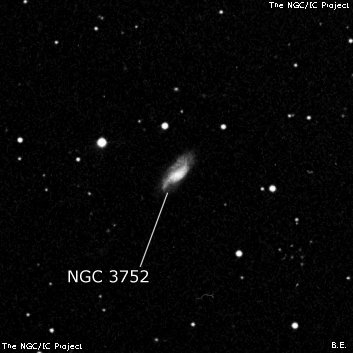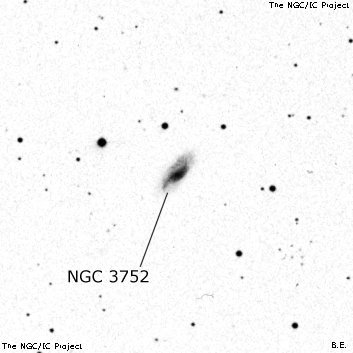NGC/IC Project Restoration Effort
(This is a very very beta version)
NGC3752


Basic Information
Location and Magnitude
Right Ascension: 11:32:32.3
Declination: +74:37:43
Constellation: DRA
Visual Magnitude: 12.9
Historic Information
Discoverer: Herschel W.
Year of discovery: 1801
Discovery aperture: 18.7
Observational
Summary description: pB, pL
Sub-type: Sab
Corwin's Notes
=====
NGC 3752. The night of 2 April 1801 was, as far as WH and CH were concerned,
a typical observing night. They made only one sweep that night, number 1096,
and found fifteen new nebulae in it. They also recorded four stars, but only
one had a catalogued position, 4 Draconis. The reductions were made under the
usual assumptions that the times and north polar indices could be reduced to
RA and NPD by reference to the single catalogued star, 4 Draconis.
Unfortunately, unknown to them, the telescope was not sweeping along the
meridian, but along a great circle seven degrees east of the meridian. WH did
not discover this until a few days later. Appended to his sweep of 5 April is
this note:
On examination, I find by an accident of taking down the 25 feet telescope,
my instrument has been drawn out of the meridian towards the east at least
5 or 6 degrees in azimuthe [sic], perhaps more.
He discarded the April 5th sweep, but did not realize that the same problem
affected the April 2nd sweep. The only indication he gives that something
might be wrong is this note at the end of Sweep 1096 on 2 April:
4 Draconis Hevelii as taken from Bode's Cat. (NB Woll[aston] & Bode agree)
gives 1' 46" more minus than when it was determined (in the Origional [sic]
Sweep) by 5 Draconis Hevelii of 1099 Sw; but the place from the Catalogue
appears to be the most correct, as it agrees better with another additional
star (206) [sic] Cam.) taken in that sweep; besides by 1066 and 1668 [sic;
1068 is probably meant as there is no sweep "1668"] sweeps it seems that 5
Draconis Hev. did not give so strong a correction minus, as some other
stars.
(The discarded sweep of 5 April 1801, by the way, has only 7 objects included
-- four stars, a double star, and two "vF, vS" nebulae, both confirmed with
the 300X eyepiece. There is a note at the top of this short sweep "Not to be
Numbered or registered", clearly motivated by the alignment problem. I'll
reduce this someday to find out what WH saw that night.)
In 2011-12, Wolfgang Steinicke had the opportunity to examine WH's and CH's
original records now in the possession of the RAS in London. Doing so, he
found the problem with telescope alignment, and was able to properly reduce
the observations of sweep 1096.
In the meantime, however, I had already tackled the problem and -- without
realizing its origin -- had managed to recover all of the galaxies that WH
found. Here are my original notes on the matter, with new material inserted
in square brackets. I thank Wolfgang for correspondence about this, and
answers to my subsequent questions, early in 2013. I'm also grateful to
Courtney Seligman who brought this up again in June 2015 in the context of the
identification of NGC 2938 (which see).
The problem is discussed in an article in Monthly Notices (Volume 71, pages
509-511) in 1911 where the anonymous author [possibly the Astronomer Royal
at the time, Frank Dyson; though Wolfgang has found the relevant
correspondence between the previous Astronomer Royal, William Christie, and
Dreyer] gives accurate positions for forty nebulae. These were found on
Royal Observatory, Greenwich (RGO in modern parlance) 30-inch plates
covering the area of WH's sweep 1096 on 2 April 1801. WH's positions in
that sweep are affected by a large, systematic error, so Dreyer had
requested that the Astronomer Royal have plates taken in an effort to sort
out the problems.
They largely succeeded, but the paper is incorrect in saying in a note that
h917 = N3752; actually, N3752 = H II 905. Dreyer and the article's author
correctly concluded that h917 and H II 905 are two different galaxies, but
they got the NGC number on the wrong one. The MN note should actually read
"NGC 3752 = No. 36 above = H II 905, but not h 917 = No. 38 above." This
unfortunately leaves h917 without an NGC number (see its entry in the
"notngc" files. (Following the time-honored tradition of muddying the
waters with suffixes, I suppose we could call it "NGC 3752A", but I've not
done that. Yet. I may eventually change my mind.) (But as of April 2016,
I haven't.)
Since John Herschel gave his own position, but his father's description, to
GC 2460 = NGC 3752, and since it is clear that WH saw the brighter of the
two galaxies (more on this below), the GC and NGC positions should be
changed.
To reach these conclusions, I re-reduced WH's offsets from his comparison
stars (as given by Dreyer in the Scientific Papers) [Dreyer must have seen
WH's note about the 4 Draconis problem as he identified and used the other
stars, not 4 Draconis, to calculate new offsets for the nebulae] for all the
objects in the sweep, using the SAO positions for the stars. The positions
for the nebulae so found are very poor, ranging up to almost 6 minutes of
time and 45 arcmin from the true positions. Nevertheless, there are no
other galaxies in the area of WH's positions that could match his
descriptions. By following along chronologically through the sweep, we can
be pretty sure which galaxies correspond to which numbers in WH's list (only
H III 966 = NGC 3197 is out of RA order, but its identity is clear from the
declination). This includes N3752 which, as Steve Gottlieb independently
suggested, is certainly H II 905.
Further "proof" of the correctness of these identifications comes from plots
(shown in crude form below) of the differences between WH's positions and
the true positions from the RGO plates. (By the way, I've verified the RGO
positions with modern measurements.) The differences are systematic,
increasing towards higher right ascension. Though [Dreyer] used three
different comparison stars for these observations, he used one of these,
BD +78 317, for only one object; another, BD +78 412, for two; but the
third, BD +76 393, for the remaining 12 objects. [At this point, I had a
note about Dreyer's use of the these three stars and the possible problems
that might introduce; all that is no longer relevant since I found WH's note
about 4 Draconis.] For this third star in particular, the systematic errors
are therefore quite well-determined. If corrected for these systematic
errors, WH's positions would be good to his nominal accuracy of a few
arcminutes.
To clinch this interpretation, I calculated the offset of John Herschel's
position for h917 from the true position of N3752 = H II 905. The resulting
points are coincidentally very close to the offset predicted if [Dreyer] had
used BD +78 412 as his comparison star. But, as we can see on the graph,
the points are very discrepant from the offset of the actual comparison star
BD +76 393. So, again, N3752 is almost certainly II 905 and not h917.
Here is a list of the galaxies from the 1911 MNRAS paper, along with the NGC
numbers, the numbers assigned by other observers, and the differences
between WH's positions and the RGO positions. The objects flagged with
asterisks are those found by WH during sweep 1096.
MN NGC WH Others Delta RA Delta Dec
(WH - RGO)
1* 2938 III 963 [h 612, a star] -1m 54s -17.8 arcmin
3* 2977 I 282 -3 17 -17.5
6* 3061 II 903 [h 653, not found] -1 49 -14.3
7* 3197 III 966 +1 34 + 6.9
8* 3144=3174 III 964 d'Arrest -2 16 - 2.1
9* 3155=3194 III 965 h 676, d'Arrest -1 53 - 0.9
11* 3183=3218 I 283 d'Arrest -2 25 + 1.2
13 3252 III 316 --- ---
15* 3329=3397 I 284 h 733 +4 01 +26.6
25 3403 II 335 h 767 --- ---
27* 3465 III 967 h 795 [h 802, n.f.] +0 50 +11.4
29* 3500 III 968 -1 33 +10.7
30* 3523 II 904 +1 12 + 9.9
34 3538 ... d'Arrest --- ---
36* 3752 II 905 +2 29 +14.8
37* 3747 III 969 +1 51 +12.7
38 .... ... [h 917, a star] (+5 22 +39.1)
39* 3901 III 970 +5 40 +42.9
40* 3890=3939 III 971 H III 940, d'Arrest +1 43 +25.3
Finally, here is a crude representation of the plot of the position
differences, taken in the sense WH minus RGO:
Delta Dec
(arcmin)
-- + Comparison stars used
* = BD +76 393
+40 -- (*) N3752 if h 917 + = BD +78 412
x = BD +78 317
--
+30 --
-- * +
+20 --
-- * N3752 if II 905
*
+10 -- ***
x
--
*
0 -- *
*
--
-10 --
-- *
-20 -- * *
| | | | | | |
12h 11h30m 11h 10h30m 10h 9h30m 9h
RA
Delta RA
(minutes)
+6 --
+
+5 -- (*) N3752 if h 917
+4 -- +
+3 --
* N3752 if II 905
+2 -- *
* x
+1 -- * *
0 --
-1 --
*
-2 -- * * *
* *
-3 --
*
-4 --
| | | | | | |
12h 11h30m 11h 10h30m 10h 9h30m 9h
RA
Steve's Notes
=====
NGC 3752
17.5" (4/18/98): fairly faint, moderately large. At first this galaxy appeared roundish (probably viewing the core only), but then fainter extensions were seen NW-SE, increasing the dimensions to 1.2'x0.6'. Forms a triangle with two mag 11/13 stars 2.4' ENE and 1.4' NNE, respectively, and several other stars trail off towards the SW.



